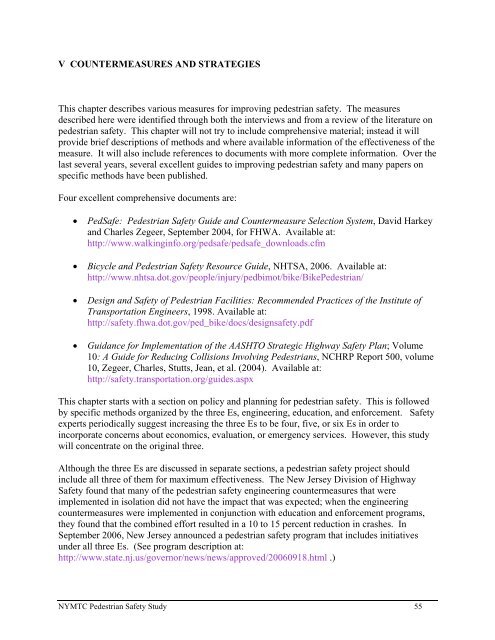NYMTC Regional Pedestrian Safety Study - New York Metropolitan ...
NYMTC Regional Pedestrian Safety Study - New York Metropolitan ...
NYMTC Regional Pedestrian Safety Study - New York Metropolitan ...
Create successful ePaper yourself
Turn your PDF publications into a flip-book with our unique Google optimized e-Paper software.
V COUNTERMEASURES AND STRATEGIES<br />
This chapter describes various measures for improving pedestrian safety. The measures<br />
described here were identified through both the interviews and from a review of the literature on<br />
pedestrian safety. This chapter will not try to include comprehensive material; instead it will<br />
provide brief descriptions of methods and where available information of the effectiveness of the<br />
measure. It will also include references to documents with more complete information. Over the<br />
last several years, several excellent guides to improving pedestrian safety and many papers on<br />
specific methods have been published.<br />
Four excellent comprehensive documents are:<br />
• PedSafe: <strong>Pedestrian</strong> <strong>Safety</strong> Guide and Countermeasure Selection System, David Harkey<br />
and Charles Zegeer, September 2004, for FHWA. Available at:<br />
http://www.walkinginfo.org/pedsafe/pedsafe_downloads.cfm<br />
• Bicycle and <strong>Pedestrian</strong> <strong>Safety</strong> Resource Guide, NHTSA, 2006. Available at:<br />
http://www.nhtsa.dot.gov/people/injury/pedbimot/bike/Bike<strong>Pedestrian</strong>/<br />
• Design and <strong>Safety</strong> of <strong>Pedestrian</strong> Facilities: Recommended Practices of the Institute of<br />
Transportation Engineers, 1998. Available at:<br />
http://safety.fhwa.dot.gov/ped_bike/docs/designsafety.pdf<br />
• Guidance for Implementation of the AASHTO Strategic Highway <strong>Safety</strong> Plan; Volume<br />
10: A Guide for Reducing Collisions Involving <strong>Pedestrian</strong>s, NCHRP Report 500, volume<br />
10, Zegeer, Charles, Stutts, Jean, et al. (2004). Available at:<br />
http://safety.transportation.org/guides.aspx<br />
This chapter starts with a section on policy and planning for pedestrian safety. This is followed<br />
by specific methods organized by the three Es, engineering, education, and enforcement. <strong>Safety</strong><br />
experts periodically suggest increasing the three Es to be four, five, or six Es in order to<br />
incorporate concerns about economics, evaluation, or emergency services. However, this study<br />
will concentrate on the original three.<br />
Although the three Es are discussed in separate sections, a pedestrian safety project should<br />
include all three of them for maximum effectiveness. The <strong>New</strong> Jersey Division of Highway<br />
<strong>Safety</strong> found that many of the pedestrian safety engineering countermeasures that were<br />
implemented in isolation did not have the impact that was expected; when the engineering<br />
countermeasures were implemented in conjunction with education and enforcement programs,<br />
they found that the combined effort resulted in a 10 to 15 percent reduction in crashes. In<br />
September 2006, <strong>New</strong> Jersey announced a pedestrian safety program that includes initiatives<br />
under all three Es. (See program description at:<br />
http://www.state.nj.us/governor/news/news/approved/20060918.html .)<br />
<strong>NYMTC</strong> <strong>Pedestrian</strong> <strong>Safety</strong> <strong>Study</strong> 55
















